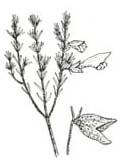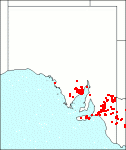Family: Lamiaceae
Prostanthera aspalathoides
Citation:
Cunn. ex Benth., Labiat. gen.spec. 453 (1834).
Synonymy: P. coccinea F. Muell., Fragm. Phyt. Aust. 6:108 (1868), partly, non F. Muell. (1855).
Common name: Scarlet mintbush, pixie caps.
Description:
Small shrub, 0.3-1 m high; branches densely hairy; hairs c. 0.1 mm long, glandular; leaf-bearing branches short to long, when short, leaves often densely clustered at the nodes of the axis, when long, branches 2-4 mm long, then leaves spread out along the branches; leaves glabrous or sparsely hairy; hairs 0.05-0.3 mm long, moderately to densely glandular; petiole absent or less than 0.5 mm long; lamina terete to compressed-terete, oblong-linear, linear-elliptic to linear-obovate, 1.5-6 rarely to 10 mm long, 0.5-1 mm wide; base slightly attenuate; margin entire, recurved when lamina subterete; apex obtuse to rounded; venation not visible.
Pedicel 2-3 mm long, hairy or glabrous; bracteoles inserted near the distal end of the pedicel, oblong-linear, 2-3 mm long, to c. 0.5 mm wide; calyx 5-7 mm long, outer surface sparsely to densely hairy, rarely glabrous, inner surface glabrous; tube 3-4 mm long; lobes broadly ovate to triangular, 2-3 mm long, c. 3 mm wide; corolla 10-20 mm long, red, pink-red, orange, rarely yellow, usually with dark-red spots on the inner surface of the lower median lobe, outer surface hairy distally; tube 8-11 mm long, outer surface sparsely to densely hairy distally; lobes sparsely hairy on the outer surface, inner surface glabrous; lower median lobe obovate, 2-3 mm long, 2-4 mm wide; lateral lobes ovate to oblong-ovate or triangular, 1.5-3 rarely 4 mm long, 1.5-2 rarely 3 mm wide; upper median lobe-pair ovate, 5-8 mm long, 6-8 mm wide; stamens inserted c. 10 mm above the base of the corolla; Filaments 6-8 mm long, with broadly triangular glandular trichomes; anthers 1.5-2 mm long, although the appendage appearing absent, one side of the connective usually extended to form a minute basal appendage to 0.5 mm long, sometimes with broad-deltoid trichomes on the appendage; pistil 17-18 rarely 25 mm long; ovary 1-1.5 mm long; style 15-20 rarely 23 mm long; stigma lobes to 1 mm long.
Mericarps 2-2.5 mm long.

| Flowering branch and calyx.
|
Image source: fig. 555D in Jessop J.P. & Toelken H.R. (Ed.) 1986. Flora of South Australia (4th edn).
|
Published illustration:
Althofer (1978) Cradle of incense, p. 77; Cunningham et al. (1982) Plants of western New South Wales, p. 578.
|
|
Distribution:
|
This species occurs in open Mallee communities of Eucalyptus incrassata and E. socialis, with open understorey commonly of Melaleuca lanceolata, M. uncinata, Triodia sp. and other heathland plants, occasionally with Callitris preissii. It occurs on sandstones and shales, amongst sandstone outcrops, on red sandy loams, overlying granite, or in shallow, calcareous soils. Often in sandy soils with high 'buckshot' gravel content, less commonly occurring in soils with high clay content.
S.Aust.: EP, NL, MU, YP, SL, KI, SE. Qld; N.S.W.; Vic.
|
Conservation status:
native
Flowering time: July — Dec.
|

SA Distribution Map based
on current data relating to
specimens held in the
State Herbarium of South Australia
|
Biology:
There is considerable variation in the leaf size and shape of this species.
Author:
Not yet available
|

